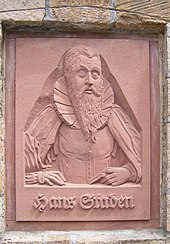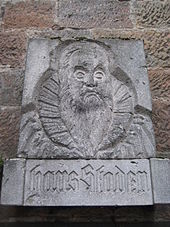Hans Staden

Hans Staden (* around 1525 in Homberg (Efze) ; † July 30, 1576 in Wolfhagen [unsecured]) was a German mercenary in the service of Portuguese settlers. He wrote the Warhaftige Historia (1557) about his two trips to Brazil . It was the first detailed book on Brazil in Germany in the 16th century. Staden was a contemporary of the Landsknecht Ulrich Schmidl , co-founder of Buenos Aires in Argentina.
life and work
In 1548 Hans Staden traveled as a mercenary to the Brazilian coastal area already known as "Brazil" and fought there in 1549 near Pernambuco against rebellious Indians. After returning, he decided in 1550 to go to the La Plata area with the Spanish Sanabria expedition . After the three ships sank in storms, he was able to save himself with several other castaways to the south Brazilian coast, where they survived in the rainforest for over two years, hoping to be rescued. Finally they drove north in a small self-made boat and came - after another shipwreck and jungle march - to São Vicente . To protect this important settlement, Staden was hired by the Portuguese to command a small fortress on the island of Santo Amaro in the north.

The island was exposed to attacks by the Tupinambá Indians, who were cannibals . During an excursion from his “bulwark”, Staden was captured by Indians who took him to their settlement Ubatuba . He was soon to be ritually killed and eaten on a Tupinambá festival. Fortunately for him, he was able to postpone this appointment again and again. He owed this fact to his physiognomy , which did not resemble a Portuguese one at all, because the Portuguese were already the Tupinambá's main enemies. The Indians were then hit by a plague. The believing Christian Staden promised the chief that he would work with his God for healing. The chief survived the plague and Stadens' status as a healer saved his life. However, Staden saw how the Tupinambá captured, killed and ate several Portuguese people. After more than nine months, he was freed by the captain of a French ship.
His book Warhaftige Historia , published in Marburg in 1557, and description of the landscape of the wild naked, grim man-eater people in the New World of America is today an extremely important work for research on Brazil. The Marburg doctor Johann Dryander arranged for the travel description to be printed . In the specialist literature, Dryander is sometimes even regarded as the actual author of the von Staden report. This is justified u. a. with the publication circumstances and the level of education Stadens. The skillful and well thought-out narrative of the report and the many details of the book, such as the mention of the medical term median-vein, suggest that the level of education of a mercenary was not sufficient to write such a work in this form. The more recent Staden research (Obermeier, Harbsmeier, Tiemann) contradicts this assumption. The stylistic-syntactic monotony with paratactically arranged main clause constructions reveals an inexperienced writer. A clear distinction, however, is the learned diction Dryander in his detailed foreword. Its function can be compared with that of a lecturer, who helped determine the layout of the work and probably only intervened in a few corrective areas. As the author of the work, he signs in two received letters with which Staden sent his work to noble patrons.
Staden was the first to describe the fertility of the soil by the Indians, which can still be observed in the Amazon today : “Wherever you want to plant, you first cut the trees and let them dry for one to three months. Then the area is set on fire and they plant their roots between the half-charred trunks. "
At the end of the book, Staden describes the animals and plants of Brazil. 17 animal species, including the armadillo , the opossum gambá and stingless bees , as well as five plant species can be clearly identified. For example, he described cotton from kapok trees and the sweet potato . It is a first report on the then unknown tropical animals and plants of the New World .
After the book was published, Staden learned how to boil saltpeter in Marburg. In his True History and a letter written to the Count of Waldeck around 1557 , he gave Wolfhagen as his place of residence. In 1558 he was last mentioned as a saltpeter boiler "vonn Corbach ". So it is unclear where he died. His father had been a citizen of Korbach since 1551 . It is historically very unlikely that Staden fell victim to the plague in 1576 .

reception
In 1925, the Brazilian author Monteiro Lobato published the youth book Meu cativeiro entre os selvagens do Brasil based on the writings of Stadens. In 1927 it appeared in a revised version under the title As Aventuras de Hans Staden . The book was very successful and is still read in schools in Brazil. Staden also became known as comic hero in Brazil.
Posthumous honors
Hans Staden - along with Carl Friedrich Philipp von Martius - is the namesake of the Martius-Staden Institute in São Paulo, which is dedicated to researching the history of German immigration to Brazil and German-Brazilian cultural exchange.
Street names in Homberg (Efze), Jundiaí (Brazil), Kassel , Korbach, Londrina (Brazil), Rio de Janeiro (Brazil), São Paulo (Brazil), Ubatuba (Brazil) and Wolfhagen are reminiscent of Hans Staden. There is a Hans Staden relief in Homberg (Efze). In Wolfhagen, in addition to a half-length portrait in stone, a memorial designed by Karin Bohrmann-Roth has been dedicated to him since 2018 . Since February 21, 2019, the city of Wolfhagen officially bears the name "Hans-Staden-Stadt Wolfhagen".
Fonts
- Real historia. Two trips to Brazil (1548–1555). Historia de duas viagens ao Brasil. Critical edition by Franz Obermeier. Fontes Americanae 1. Westensee-Verlag, Kiel 2007, ISBN 978-3-931368-70-8 .
- Brazil - The True History of the Wild, Naked, Fierce Man-Eater People - 1548–1555. Edited and introduced by Gustav Faber. Thienemann, Edition Erdmann, Stuttgart 1984, ISBN 3-522-60460-1 .
literature
(in order of appearance)
- Richard Andree: Hans Staden von Homberg among the cannibalist Tupinambas (1547–1554) . In: Otto Spanner (Hrsg.): Real and true robinsonades, trips and travel experiences from all zones. Otto Spanner's youth and home library . Second series, eleventh volume. Verlag Otto Spanner, Leipzig 1868, p. 17-40 ( books.google.de ).
- Friedrich Ratzel : Staden, Hans . In: Allgemeine Deutsche Biographie (ADB). Volume 35, Duncker & Humblot, Leipzig 1893, pp. 364-366.
- Kurt Salecker: Ubatuba - From the adventurous life of the German Brazilian driver Hans Staden . R. Brockhaus, Wuppertal 1967.
- Georg Bremer: Among cannibals: The unheard of adventures of the German conquistadors Hans Staden and Ulrich Schmidel . Schweizer Verl.-Haus, Zurich 1996, ISBN 3-7263-6705-5 .
- Michael Harbsmeier: The benefits and disadvantages of studying older travelogues. On the rediscovery of Hans Stadens in the 19th and 20th centuries . In: Walther Bernecker, Gertrut Krömer (ed.): The rediscovery of Latin America. The experience of the subcontinent in travelogues of the 19th century . Vervuert, Frankfurt am Main 1997. 3-89354-738-XS 79-105.
- Franz Obermeier: Hans Staden: Warhaftige Historia. Two trips to Brazil (1548–1555) História de duas viagens ao Brasil . Critical edition / Edição critica: Franz Obermeier. Translation into today's German: Joachim Tiemann. Tradução ao português: Guiomar Carvalho Franco. Revisão: Augusto Rodrigues. Westensee Verlag, Kiel 2007, ISBN 978-3-931368-70-8 .
- Wolf Lustig: A Junesche been ermiuramme. The implementation of Hans Stadens 'True [r] history of the wild, naked, grim ogre-eaters' as a 're-tupation' of the European-Brazilian encounter . In: Fendler, Ute (ed.): Discovery, Conquest, Staging: Cinematic versions of the colonial history of Latin America and Africa . Meidenbauer, Munich 2007. pp. 77-100.
- Wolfgang Schiffner u. a .: Among man-eater-Leuthen. Entre as gentes antropófagas. O livro de Hans Staden de 1557. Hans Staden's Book of Brazil from 1557. Regional Museum Wolfhager Land, Wolfhagen 2007, ISBN 978-3-924219-20-8 .
- Franz Obermeier, Wolfgang Schiffner (ed.): The Truthful Historia - the first book on Brazil. Files from the Wolfhager Congress on 450 years of Hans Staden reception. Fontes Americanae 2. Westensee-Verlag, Kiel 2008, ISBN 978-3-931368-68-5 .
- Franz Obermeier: Staden, Hans. In: New German Biography (NDB). Volume 24, Duncker & Humblot, Berlin 2010, ISBN 978-3-428-11205-0 , p. 784 f. ( Digitized version ).
- Markus Klaus Schäffauer: The vision of the eaten: Hans Staden, author of cannibalism . In: Alexandra Curvelo u. Madalena Simões (ed.): Portugal and the Holy Roman Empire (16th – 18th centuries) . Aschendorff, Münster 2011, ISBN 978-3-402-14901-0 , pp. 105-126 .
- Eve M. Duffy, Alida Metcalf: The Return of Hans Staden. A Go-between in the Atlantic World . The Johns Hopkins University Press, Baltimore 2012, ISBN 978-1-4214-0346-5 .
Web links
- Literature by and about Hans Staden in the catalog of the German National Library
Works in full text
- Hans Staden - Truthful Historia in the Internet Archive
- Works by Hans Staden in the Gutenberg-DE project
Others
- Instituto Martius-Staden, São Paulo
- Staden department in the Wolfhager Land Regional Museum, Wolfhagen
- Franz Obermeier: Pictures of cannibals, cannibalism in pictures. Brazilian Indians in Pictures and Texts from the 16th Century (PDF; 111 kB). In: Yearbook of Latin American History. 38: 49-72. Böhlau, Cologne / Weimar / Vienna 2001.
- Karl-Ludolf Hübener: As a Hessian Landsknecht in Brazil - The adventurous life of Hans Staden , SWR2 “Knowledge” from May 25, 2015
Individual evidence
- ↑ Thales de Azevedo: Povoamento da Cidade do Salvado. Publicação da Prefeitura Municipal do Salvador Comemorativa do IV Centenario da Cidade , Salvador 1949, ISBN 978-85-61458-16-4 , p. 33.
- ↑ Annerose Menninger: The power of eyewitnesses. New World and Cannibal Myth, 1492–1600. Steiner Verlag, Stuttgart 1995, ISBN 3-515-06723-X , p. 184. (Contributions to colonial and overseas history, 64)
- ^ Franz Obermeier, Wolfgang Schiffner (ed.): The Warhaftige Historia - The first Brazilian book. Files of the Wolfhager Congress on 450 years of reception in the city . Westensee-Verlag, Kiel 2008.
- ^ Gerhard Menk: The two letters of dedication from Hans Stadens to the Counts of Waldeck and Nassau. In: Journal of the Association for Hessian History and Regional Studies. 1989, pp. 63-70.
- ↑ Thales de Azevedo: a. a. O, p. 365 f.
- ↑ Wolf Engels & Sabine Heinle: Hans Staden as Triopen biologist: First descriptions of "different" animals and plants of Brazil in his book "Warhaftige Historia" from 1557 to 1522. Examples of species identified by us. In: Spixiana . Volume 37, 2014, pp. 283-287. ( Digitized version ).
- ^ Paul Görlich: Wolfhagen. History of a North Hessian city. Wolfhagen 1980, p. 433.
- ^ Karl-Ludolf Hübener: As a Hessian Landsknecht in Brazil. The adventurous life of Hans Staden , SWR Wissen, 2015
- ↑ Regional Museum Wolfhager Land
- ^ O Instituto Martius-Staden de Ciências, Letras e Intercâmbio Cultural Brasileiro-Alemão , accessed on February 27, 2014.
- ^ Björn Friedrichs: Sculpture of the Wolfhag adventurer Hans Staden unveiled on Hospitalplatz. In: hna.de. Hessische / Niedersächsische Allgemeine HNA, June 9, 2018, accessed on December 16, 2018 .
- ^ City of Wolfhagen - message: Wolfhagen now officially "Hans-Staden-Stadt". Retrieved December 13, 2019 .
| personal data | |
|---|---|
| SURNAME | Staden, Hans |
| BRIEF DESCRIPTION | German Landsknecht in the service of Portuguese conquistadors and explorers |
| DATE OF BIRTH | around 1525 |
| PLACE OF BIRTH | Homberg (Efze) |
| DATE OF DEATH | July 30, 1576 |
| Place of death | unsure: Wolfhagen |